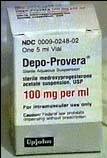 |
 |
 (medroxyprogesterone), which is
injected at approximately 3 month intervals. It is also
used for "chemical castration" of sexual offenders. It works in two
ways: by suppressing ovulation (contraceptive) or thinning the uterus
so that newly
conceived children cannot implant, thus starving them to death
(abortifacient). Depo is popular among doctors
because it requires an office visit every 3 months, generating more
profit than other contraceptives.
(medroxyprogesterone), which is
injected at approximately 3 month intervals. It is also
used for "chemical castration" of sexual offenders. It works in two
ways: by suppressing ovulation (contraceptive) or thinning the uterus
so that newly
conceived children cannot implant, thus starving them to death
(abortifacient). Depo is popular among doctors
because it requires an office visit every 3 months, generating more
profit than other contraceptives.
Some of Depo-Provera's acknowledged side
effects are substantial weight
gain, headache, nervousness, abdominal pain or discomfort, dizziness,
decreased libido or anorgasmia, backache, leg cramps, depression,
nausea, insomnia, white or yellowish vaginal discharge, acne,
vaginitis, breast pain, bloating, edema, hot flashes,
joint pain, galactorrhea (breast milk discharge),
changes in breast size, breast lumps or nipple bleeding, sensation of
pregnancy, painful menstruation, heavier menses, ovarian cysts, insulin
resistance, PMS, and blood clots.
Some of the side effects
are similar to those experienced in pregnancy, where progesterone is
present
for a long time. Some are far worse. Some are very long-lived, possibly
permanent, even after stopping Depo.
A "normal" side effect is the delayed return of fertility after going off the drug. It takes a median time of 10 months following the last injection to achieve pregnancy, with a "normal" range of 4 to 31 months (some users report indefinite infertility). This is unrelated to the duration of use; it doesn't matter how many injections were received.
Check out one of these
web pages run by former Depo users. Note how common
these side effects are. Plus, there have been other side effects
that aren't on "the list".
Shelly's
site is full of hundreds of horror stories
and many links
Anne's
has a place where you can sign up for a class-action
lawsuit against Pharmacia and
Upjohn. If you can't access that, call the lawyers at 662-844-2137.
Kim
has another bunch of info and links
Teresa has a comprehensive
page with about a thousand user comments
Stephanie
has another good page
There's also a Depo webring (see below on this page) in case you want a few more opinions.
The effects on your marriage are presumably similar
to those of other artificial contraceptives. For information on that,
see our Practical Theology and Marital Chastity
page.
Getting off this artificially timed hormone can be difficult, especially if you want to avoid pregnancy. The first step is to learn "normal" NFP well. (Obviously, you wouldn't want to get back on another artificial hormone like Norplant or the Pill, but would want something safe and effective.) However, the usual NFP rules, which accommodate normal things like irregular cycles, breastfeeding amenorrhea and premenopause, have problems with a hormonal system "outta whack" due to powerful external drugs.
For now, the best advice we can give is to use the
return of fertility after
childbirth and post-pill guidelines from "The Art of NFP" (see our Resources page ), with the extra caution
that we don't know whether cervical mucus will give enough warning of
impending ovulation. In addition, D-P will elevate BBT because of the
progesterone residue. Than can make the temperature sign confusing,
because it can be accompanied by fertile-looking mucus. It
appears that you are infertile as long as the temps are high. For
help, call your local CCL Chapter
(http://www.ccli.org/learn/search.shtml is a good place to
find them). They will help you through it. (We have done it, but
it was unpleasant because the clients' cycles were messed up for
months.)
A nutritional improvement may help to restore normal
fertility and cycles. A PMS diet is suggested to accomplish better
nutrition. Certain vitamins may be depleted, as is seen with birth
control pills. Refer to "Fertility, Cycles and Nutrition" by Marilyn
Shannon for specific dosages. It's the second most important book on
our resources page!
So, start charting within the 3 months after getting
your last shot. Be aware that cycling may or may not return for a long
time. Chart temps, looking for a lowering of high temps that shows you
are gradually reducing progesterone. Then look for a change in mucus to
the fertile type, assuming then that you are fertile. Then look for
ovulation confirmed by a temp rise.
As more and more women get off Depo, more experience
on the withdrawal process is gained by NFP researchers. The NFP rules
were developed over many years of
scientific research and user experience; we hope that beating the Depo
problem will not take as long. The question is, how many more women
will have to get sick?